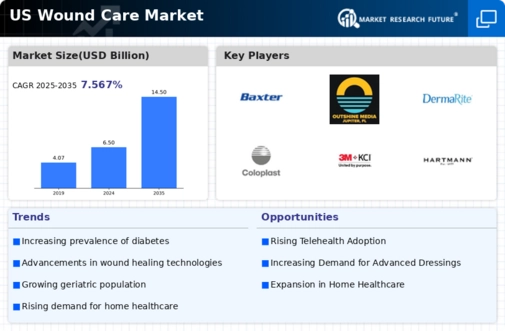Increasing Incidence of Diabetes
The rising prevalence of diabetes in the US is a critical driver for the wound care market. Diabetes often leads to chronic wounds, particularly diabetic foot ulcers, which require specialized care. According to the Centers for Disease Control and Prevention (CDC), approximately 34.2 million people in the US have diabetes, representing about 10.5% of the population. This condition significantly increases the risk of developing wounds that may become infected or require surgical intervention. As the population ages and lifestyle factors contribute to higher diabetes rates, the demand for effective wound care solutions is likely to grow. The wound care market must adapt to these needs by developing advanced products and treatment protocols tailored for diabetic patients, thereby enhancing patient outcomes and reducing healthcare costs associated with wound management.
Advancements in Wound Care Technologies
Technological innovations are transforming the wound care market, offering new solutions that enhance healing and improve patient outcomes. The introduction of advanced dressings, bioengineered tissues, and negative pressure wound therapy has revolutionized the management of complex wounds. The wound care market is witnessing a surge in research and development, with investments aimed at creating products that not only promote healing but also reduce infection rates. For instance, the market for advanced wound care products is projected to reach $12 billion by 2026, driven by these technological advancements. As healthcare providers increasingly adopt these innovative solutions, the overall efficiency and effectiveness of wound management are likely to improve, ultimately benefiting patients and healthcare systems alike.
Rising Awareness of Wound Care Management
There is a growing awareness among healthcare professionals and patients regarding the importance of effective wound care management. Educational initiatives and campaigns aimed at promoting best practices in wound care are becoming more prevalent, which is positively impacting the wound care market. Increased knowledge about the risks associated with untreated wounds, such as infections and complications, is driving demand for specialized wound care products and services. Furthermore, healthcare providers are increasingly recognizing the need for comprehensive wound care protocols, leading to a more structured approach to treatment. This heightened awareness is expected to contribute to a more proactive stance in wound management, ultimately enhancing patient outcomes and reducing the burden on healthcare systems.
Aging Population and Associated Health Issues
The demographic shift towards an older population in the US is a substantial factor influencing the wound care market. As individuals age, they often experience a decline in skin integrity and an increase in comorbidities, such as vascular diseases, which can lead to chronic wounds. The US Census Bureau projects that by 2030, all baby boomers will be over 65 years old, significantly increasing the number of individuals at risk for wounds. This demographic trend necessitates a robust response from the wound care market, which must innovate to provide effective treatments that cater to the unique needs of older adults. The financial implications are notable, as the cost of managing chronic wounds in this population can reach billions of dollars annually, emphasizing the need for efficient and effective wound care solutions.
Government Initiatives and Funding for Wound Care
Government initiatives aimed at improving healthcare access and quality are playing a pivotal role in shaping the wound care market. Various programs and funding opportunities are being introduced to support research, development, and dissemination of effective wound care practices. The Centers for Medicare & Medicaid Services (CMS) has implemented policies that incentivize healthcare providers to adopt evidence-based wound care protocols, thereby enhancing the quality of care. Additionally, federal funding for wound care research is expected to increase, fostering innovation within the wound care market. These initiatives not only aim to improve patient outcomes but also seek to reduce healthcare costs associated with chronic wound management, indicating a strategic focus on enhancing the overall efficiency of the healthcare system.



















Leave a Comment